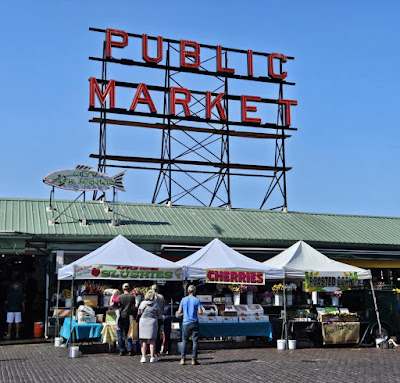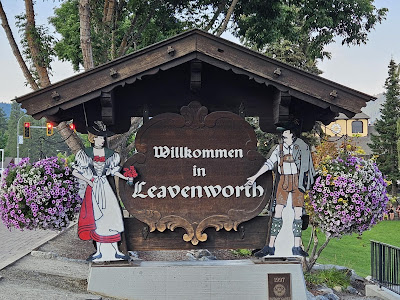On August 25, I ran the Millennium Meadows Marathon in Grand Rapids, MI. I ran this same race four years ago, so I was already familiar with the course.
I flew to Grand Rapids
Saturday morning. My flight was delayed,
but it’s a relatively short flight, so I still arrived in time for lunch. It would’ve been too early to check into my
hotel room, so I stopped for lunch before driving to my hotel.
I stayed downtown, so I
would be within walking distance of restaurants and breweries. After checking in, I did a workout in the
fitness room. By the time I was done
with my workout, packet pickup for the race had started.
Packet pickup was at a
pub on the other side of the river. It
was about a mile from my hotel, so I decided to walk. It was a sunny day with temperatures in the
80s, so I quickly regretting that I didn’t pack a pair of shorts. I don’t think I saw anyone else on the street
wearing long pants.
Later, while exploring
the neighborhood around my hotel, I discovered a small market, and I picked up
some food for breakfast. I also found an
Italian restaurant, where I later went for dinner. After dinner, I sampled beers at one of the
local breweries.
I went to bed early, but
not early enough to get a full night’s sleep.
As is so often the case, when I set my alarm early, I wake up even
earlier.
The race was held at
Millennium Park, which was about a 15-minute drive from my hotel. The most direct route included a few miles on
a two-lane road that wasn’t well lit. I
almost panicked when I turned onto this road, and immediately saw a Road Closed
sign ahead. The navigation app I was
using didn’t know anything about this road closure, and I didn’t know a good
alternate route. Fortunately, the
section that was closed was only a block or two, and I was able to detour
around it.
The race started at 6:00,
but I arrived at Millennium Park around 5:15.
There were lots of other runners arriving about the same time, but there
were still parking spaces close to the buildings.
It was a warm
morning. The temperature was in the
upper 60s at the start, and I expected it to warm up at least 10 degrees by the
time I finished. With that in mind, I
decided not to push for a fast time. I
was content to run this race without any time goal.
The course was six laps
of a paved loop through Millennium Park.
We had to run about a mile to get to the loop and another mile to get
back to the pavilion after completing our sixth lap.
It was still dark when I
arrived. It didn’t occur to me that we
might be starting the race in the dark until I saw a few other runners wearing headlamps. Talking to one of them, I learned that it
would be dark for our first lap. There
aren’t any lights along the trail, so the website recommended starting with a
light. Somehow, I missed that. When I ran this race four years ago, it must
have had a later start time. My
recollection is that I ran the entire race in daylight.
While I was lining up to
start the race, I bumped into my friend, Tim.
Tim had a light, so I decided to run the first lap with Tim, to make
sure I could see the trail.
The first mile of the race
took us through an area of the park called the Meadows. We started on a concrete sidewalk that took
us to a long wooden bridge. I’m always
cautious about my footing crossing bridges like this one. Running across it in the dark made me
nervous.
I did my best to stay
close to Tim, so I could see where his light was shining. Most of the other runners around us didn’t
bring lights.
For the first few minutes
of the race, staying with Tim wasn’t easy.
There were too many runners crowded onto a narrow trail.
After crossing the
bridge, we started running downhill. I
remember running down this hill before, but it was more uncomfortable doing it
in the dark. Even with Tim’s light, I
couldn’t see very far in front of us.
We eventually made a
hairpin turn onto a paved road that led us to the main loop. Throughout this section of the race, I found
the pace to be slightly tiring. When I’ve
run with Tim in other races, it’s always been during a multi-day series. I didn’t know what pace Tim would run in a
standalone race.
Our time for the first
mile was 8:46. At that pace, we would
finish the race in 3:50. I knew I wouldn’t
run that fast on such a warm day. Already,
I was feeling the humidity. I kept
running with Tim so I wouldn’t have to find my way without any light. I expected to slow down later.
Now, we were on the main
loop. Right where we started the loop,
there was an aid station, and I drank some water.
When we finished the
second mile, I could hear my watch vibrating, but I didn’t see what our time
was. Tim said we were slowing down. Out pace was now slower than nine minutes.
Somewhere in the next
mile, I came close to tripping. There
were places where roots were pushing up the pavement. They were easy to see in daylight, but in the
dark, I didn’t always see them. At one
point, I felt one of my shoes scraping over the top of one of those bumps.
In mile three, our pace
was 9:06. I still felt like the pace was
too fast, but I continued to keep up with Tim.
The first half of the
loop was flat, but the second half had a series of small hills. In the next two miles, we slowed down a
bit. Now, our pace was closer to
9:30. I was fine with that.
As we neared the end of
our first lap, Tim said he wanted to see if he could speed up. I was just starting to get comfortable. By now, there was enough light to see the
trail, so I let Tim go ahead, and I continued at my own pace.
In the second lap, I
gradually slowed down. By the end of
that lap, my pace was closer to 10 minutes per mile. It was too warm and humid to run a fast time,
so I gradually eased back to a pace that felt comfortable.
When I was running with
Tim, we were keeping up with the other runners around us. Now that I was slowing down, other runners
were constantly passing me. The only
runners I was passing were the ones who took the 5 AM early start. Those runners were going much slower.
Late in my second lap, I
was passed by three runners who were going much faster than everyone else. There was a half marathon that started later
than the marathon. I assumed these
runners were the leaders of the half marathon.
Soon, I started to see other fast runners going by.
I was almost done with
that lap when I recognized one of the runners who took the early start. It was my friend, Rich. As it happens, I’ve wanted to talk to Rich
about another race that we’re both planning to run in November. I slowed down and walked with Rich for at
least half a mile, so we could talk.
Eventually, I needed to
leave Rich behind and resume running.
Shortly after I resumed running, I started to feel rumblings in my
intestines. I needed to made a bathroom
stop at the next opportunity. By now, I
was already half a mile past the aid station at the start of the loop. I knew there was a port-o-potty there. There was also an aid station about halfway
through the loop, but that was in a more remote location. I didn’t know if there was a port-o-potty at
that aid station. It might be three and
a half miles before I could make a bathroom stop.
As it turns out, there
was a port-o-potty at the more remote aid station, but I didn’t see it. There was a line of volunteers at the aid
station, handing out cups of water or Gatorade.
I couldn’t see that there was a port-o-potty behind them. Instead, I pressed on for the rest of the
lap. My pace in that lap was about 10
minutes per mile. I didn’t dare try to
run any faster than that.
The halfway point was
just before the end of the third lap. I
got there in 2:09:07. At the time, I had
no idea if I would be faster or slower in the second half. As it turns out, the second half was much
slower.
When I finished that lap,
I saw that the port-o-potty at the aid station was occupied. I had no choice. I had to wait.
As I started my fourth
lap, I was surrounded by runners going different paces. We weren’t all on the same lap, and several
of the runners I was seeing were doing the half marathon. I noticed one runner who seemed to be going
at about my pace, so I started running with her. Her name was Zoe.
I started a conversation
with Zoe, and I learned that this was her second marathon. She was with three friends, but one of her
friends was much faster, and the other two were doing the half marathon. Zoe’s goal was to not be too much slower than
her friends.
I started running with
Zoe, because she seemed to be going at the right pace. It wasn’t long before I started to feel like
her pace might be too fast for me. I had
to pick up my effort to keep up with her, but I was willing to do that now that
I was in the second half of the race.
One of the noteworthy things
about this race is the mile markers.
Multi-lap courses don’t usually have mile markers for every mile of the
race. This one does. Each mile was marked with a sign and a chalk
line. The loop was about four miles long,
so in any given lap, only four of the mile markers were relevant. You had to ignore the others.
When we finished mile 14,
my time for that mile was misleading. It
included my bathroom stop. It wasn’t
until we finished mile 15 that I realized we had sped up to 9:04. That’s about the pace I was running at the
beginning of the race.
I was enjoying my conversation
with Zoe, but I couldn’t keep up that pace for the rest of the race. I told her to feel free to go on ahead if I
started to slow her down. She said if
anything, she would be the one to slow down and let me go on ahead. It turns out that neither one of us was comfortable
with the pace we were running. I was
trying to keep up with her, and she was trying to keep up with me. When we realized that, we slowed down. For the rest of that lap, our pace was closer
to 9:30. That was more comfortable for
me, but it was still too fast for Zoe.
This wasn’t Zoe’s first marathon,
so I wasn’t expecting her to have any trouble finishing. What I didn’t know at first was that her
first marathon was four years ago. Her
longest run this year was 21 miles. Once
I understood that, I realized the last lap or two might be difficult for her. From that point on, I treated her just like
someone doing their first marathon.
As we started our fifth
lap, Zoe needed to take a brief walking break.
When we resumed running it was at a slower pace. Now, our pace was about 11 minutes per
mile. I decided to slow down with her
and keep her company for the rest of the race, even though the pace was
uncomfortably slow at times.
In the second half of
that lap, we walked the hills. Those
miles were slow, but the last lap was much slower. Even when she was running, Zoe’s pace was too
slow for me to run comfortably. At
times, it was easier for me to walk at the same pace she was running.
Our pace slowed to 13
minutes, then 14 minutes. It was getting
hotter, and the sun was higher in the sky.
The course has a lot of shade, but there’s a section in the second half
of the loop where you feel the sun.
After finishing our last
lap, we still had about a mile to go to get to the finish. Zoe started to pick up her pace. Then I reminded her that the last mile would
have an uphill section. In the first
mile of the race, we ran downhill after crossing the bridge. We had to go back up that hill. When I told her that, she conserved her
energy.
I was thinking we would
go back exactly the same way we came. In
fact, our route going back was slightly different. We didn’t cross the bridge again. Instead, we turned onto a different path that
brought us around from a different direction.
As a result, we didn’t have to climb all the way to the bridge, which
had been the highest point on the course.
When we passed the “26”
sign, Zoe picked up her pace. I sped up
too and ran alongside her all the way to the finish line. I finished in 4:49:39. That’s slower than I originally expected to
run, but I was OK with that. Zoe’s three
friends all met her at the finish line.
The finisher medals depict
the bridge that we crossed at the beginning of the race. It’s the signature feature of this course.
This course had lots of
nice scenery. At times, we were running
next to a stream. In general, this is a
beautiful park. Sadly, I didn’t take any
pictures. Had I known I would be running
this slowly, I would’ve brought my phone to take pictures.
There was a volunteer
next to the finish line handing out ice pops.
After finishing an ice pop, I made my way to the pavilion, where there
was a variety of finish line food. Among
other things, they had hot dogs and beer.











































